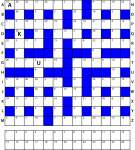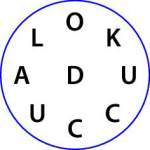Posts tagged Word puzzle
Codeword
Jun 12th
I see this is only my second post in the past week, so sorry for the lower quantity of puzzles. I’m somewhat puzzled-out during the day creating lots of different types, so I’ve spent less time on making them for my blog where I don’t have a deadline to meet! ![]()
Today I’ve decided to post a Codeword, simply because I’ve never posted one before and I thought it would be fun to have one – it’s not a very original puzzle, but I probably need a few everyday puzzles in order to make the unusual ones stand out more! ![]() The aim of a Codeword puzzle is simply to work out which letter is represented by each value – all 26 letters must be placed at least once into the grid, and each number represents a different letter. The result should be a completed crossword grid, full of English words (and without proper nouns).
The aim of a Codeword puzzle is simply to work out which letter is represented by each value – all 26 letters must be placed at least once into the grid, and each number represents a different letter. The result should be a completed crossword grid, full of English words (and without proper nouns).
Good luck! ![]()
Word Square
Jun 10th
I’ve been working on all sorts of puzzles the past few days – from codewords to skyscraper sudoku to all sorts of word puzzles, including the attached: a word square. None of the ones I’ve made for the current book I’m working on are quite as large as this, however!
The aim is simple – by starting on any letter and moving from square to adjacent square in any direction, including diagonals, how many words can you form? For each word you cannot visit a square more than once on your path. For example, starting at the left you could make ‘TEND’ by running up the left column and then across, but you could not go on to also make ‘TENDED’ because that would be reusing at least the ‘D’.
There is an 18-letter word in there for you to find. If you find 100 words you’ve done well; if you find 140 you’ve done extremely well; and if you get to 175 then frankly I’m amazed! Any reasonable English word is valid, so long as it can be written without a capital letter.
Good luck!
Something completely different – a word wheel
May 14th
Just for a change from Sudoku, I thought I’d upload a different type of puzzle today (I might also add a Sudoku variant later, if I have time!). This is a more traditional type of puzzle – a word wheel.
The idea is to form as many words as you can by using a selection of letters from the wheel no more than once each per word – and every word must include the centre letter. Words must be 3 letters or longer, and be a regular English word. For example in the wheel here we could form “LAD” as one of our words.
I found 24 words. Bonus points if you can spot my choice of 9-letter word that is in there! (or perhaps that should be a negative bonus if you don’t! ![]() )
)
Word ladder solutions
Apr 30th

Tricky Clones solution
Lovely Manors solution
Tough Places solution
Easy Life solution
Just a quick post to give the solutions I have for the word ladders I posted last week. There are sure to be alternative solutions, including one I found already with one less step for TRICKY CLONES as mentioned previously (not shown in the solution here, which uses the given number of steps).
Something different: Word ladders
Apr 21st
I’ll return to Sudoku very shortly, but today I thought I’d try something completely different. I’ve been working on various word puzzles for a new book, and thought that I’d post some of them here from time to time.
The attached puzzles here are four regular word ladders, albeit written on their sides if you open and view the PDFs. They were popularised in the late 19th century by Lewis Carroll, author of Alice’s Adventures in Wonderland (so I’m not claiming they’re anything new! ![]() ).
).
The rules are simple – by changing just one letter at each stage, can you move from the first word to the last word whilst using only standard English words in-between? I have a solution for each of these, and I’ve avoided any obscure words in order to keep it nice and fair.
For a simple example, you could change THE to SEA in three steps like this: THE -> SHE ->SEE -> SEE.
(By the way, using an unusual plural you can do the TRICKY CLONES one in one less step than the puzzle shows. ![]() )
)
Incidentally, I’m considering trying diagonal consecutive Sudoku for my next Sudoku puzzle – I just need to decide how to display this on the printed grid! Hollow slashes between two cells are a bit confusing because they seem to point at two different adjacent cells when they indicate consecutive-ness between diagonal cells (and look odd when they overlap), so I might have to experiment a bit to get it to work nicely. Perhaps two slashes, one in the corner of each diagonally-consecutive cell, would be best.








Recent Comments